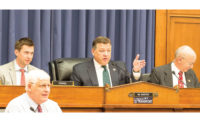House Transportation and Infrastructure Committee leaders have unveiled a proposed transportation bill that would authorize $325 billion over six years, but the proposal has a big hole: at best it would have just three years' actual funding.
The proposal, titled the Surface Transportation Reauthorization and Reform Act, would authorize $261 billion for highway construction, $55 billion for public transit and $9 billion or so for highway safety programs, over six years, staffers told reporters at an Oct. 16 Capitol Hill briefing.
The estimated funding is based on Congressional Budget Office baseline funding projections and represents a small increase over current levels.
But the Highway Trust Fund's projected balances would fall at least $30 billion short of covering the new bill's three-year authorization total. Aides told reporters in a Oct. 16 briefing the expect that the Ways and Means Committee will find the sums needed to fully fund three years.
If Ways and Means does come through, another critical point would come at the end of the bill's third year, fiscal 2018. At that stage, if Congress doesn't provide a further infusion of more than $40 billion, the new bill has a provision that would block its highway and transit authorizations for fiscal 2019 through 2021.
The measure is slated for a Transportation and Infrastructure Committee vote on Oct. 22. It should clear the panel easily, because the panel’s chairman, Bill Shuster (R-Pa.), its top Democrat, Peter DeFazio (Ore.), and other key members back it.
Although Ways and Means is drafting its revenue proposal, aides said Shuster has made clear that yet another short-term stopgap will be needed to keep highway and transit programs going past Oct. 29, when the current extension expires.
Staffers also said the bill would put a new focus on infrastructure to serve freight transportation, especiallly through a new program of competitive, discretionary grants for Nationally Significant Freight and Highway Projects. It would be funded at $4.5 billion over six years.
Staffers said the measure would provide regulatory relief and consolidate several existing U.S. Dept. of Transportation offices, including those that deal with federal TIFIA loans, rail loans and innovative financing.
Committee Democrats are “happy to see something actually moving forward,” one staffer said. She added, "We’re not excited by the funding levels, but we did include a provision...that would allow for funding levels to increase over time, if Congress is able to come up with more money.”
If Ways and Means does find the needed $30 billion or more to fully fund three years—and if the full House approves the package—negotiations would begin to work out differences between it and a highway-transit bill that the Senate approved on July 30.
That bill, the Developing a Reliable and Innovative Vision for the Economy, or DRIVE, Act, authorizes $350 billion over six years but only has funding for three. The Senate Finance Committee located $47 billion in revenue-raisers and other offsets to fully fund the DRIVE Act’s first three years.
Two key DRIVE Act architects—Senate Environment and Public Works Committee Chairman and the panel’s ranking Democrat, Barbara Boxer (Calif.)—welcomed the release of the House proposal. They said in a statement: “We are very pleased that the House is moving forward with a long-term, bipartisan bill. We look forward to getting to conference and resolving the differences in the two bills.”

